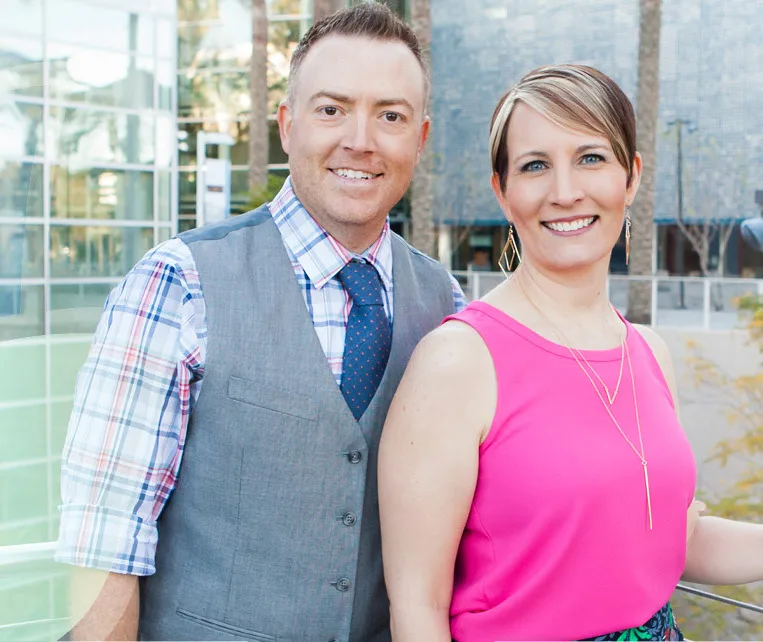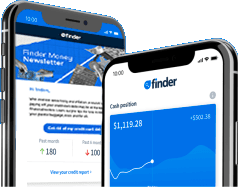With the nation’s total credit card debt sitting at a whopping $815 billion, with 8% of that debt overdue for 90 days or more, a small piece of plastic can feel like a giant weight for many Americans.
According to data from the Federal Reserve, if that debt were spread evenly across all credit card account in the US, each of our cards would carry an outstanding $1,741.35. In reality, however, individual debt is much, much more.
While it can be hard to see light at the end of the tunnel, getting out from under debt is possible. It just requires a lot of dedication and discipline.
To prove it, we’ve rounded up a handful of Credit Card Debt Crushers who managed to get back in the black with their finances. By passing along their strategies, they hope to get you there too.
 Name: Kelsa and Michael Dickey
Name: Kelsa and Michael Dickey
Paid off: $67,000
Blogs: Financial Coach Academy and Fiscal Fitness Phoenix
Kelsa and Michael successfully paid off $67,000 and now live with no debt, except for a mortgage.
Well on the road to financial freedom, they’ve now made it their mission to help others work toward living a debt-free life. Over the past 10 years, Michael and Kelsa have coached their clients to pay off an average $22,000, with the most paid off a high $215,000.
When it comes to paying off debt, they focus on four strategies to motivate nearly any personality.
| Strategies |
|---|
|
Kelsa and Michael Dickey are the founders of Fiscal Fitness, a business that helps people take the stress out of money, and Financial Coach Academy, an online community and financial training program.
 Name: Kelly Hayes-Raitt
Name: Kelly Hayes-Raitt
Paid off: $90,000
Blogs: House Sit Diva
By 2001, Kelly Hayes-Raitt had racked up $90,000 in credit card debt. She paid off her last balance in April 2010 and now lives debt-free, except for a mortgage.
After 9/11, Kelly found her business headed in a negative direction. Determined to stay optimistic, she kept her employees for one day too many with the help of credit cards.
Faced with $90,000 in debt, Kelly developed a unique strategy to pay it all off — and she ended up discovering a long-term career along the way. In the beginning, Kelly focused on keeping her interest rates as low as possible, moving balances among cards offering 0% intro APRs. But she realized in 2008 that her credit was at risk of “drying up” and knew a drastic decision was in order to increase her cash flow. And so she rented out her own home for income and became a “house sitter,” whereby she lived rent-free in exchange for caring for people’s homes and pets while they were on vacation.
Although Kelly’s method is extreme for many, it highlights a strategy that nearly anyone can benefit from.
| Strategies |
|---|
|
Kelly Hayes-Raitt is the author of How to Become a Housesitter: Insider Tips from the HouseSit Diva.
 Name: Sumit Bansal
Name: Sumit Bansal
Paid off: $8,000
Blogs: Craft of Blogging
Sumit Bansal took a leap of faith — and a large cut in income — when he left his job as an IT marketing manager to pursue his own business. He was able to make ends meet early on, but he hit a financial barrier when he realized he’d overlooked the true cost of growing a blog. With operating costs mounting, Sumit found himself more than $8,000 in credit card debt.
The expenses were necessary to develop his business, but Sumit was ready to curb his debts’ growth. Overall, he knew he needed to reduce his expenses while increasing his income. He audited both his personal and online business expenses, slashing those that weren’t critical for growth. He then worked on increasing his income by developing an online course and promoting affiliate products.
Asked for advice he’d give others looking to take charge of their credit card debt, Sumit offers three universal tips.
| Strategies |
|---|
|
A blogger for more than three years, Sumit Bansal is the founder of Craft of Blogging, which teaches people how to start and grow their own blogs.
 Name: Brian Davis
Name: Brian Davis
Paid off: $12,000
Blog: Spark Rental
Finding himself $12,000 deep in credit card debt, Brian Davis was motivated to regain a clean financial slate. But he needed the discipline to get started.
Brian took a step back to discover how he could simultaneously minimize every expense while also maximizing his income. It took a lot of willpower to spend only a fraction of his earnings each month, but he was able to pay off his debt in a mere eight months.
Here’s what Brian recommends to tackle your own debts.
| Strategies |
|---|
|
Brian is cofounder of Spark Rental, where he writes about personal finance, real estate investing, passive income and financial independence. He’s also served as a real estate expert for Forbes, USA Today and MarketWatch, to name a few.
 Name: Patrick Antinozzi
Name: Patrick Antinozzi
Paid off: $14,000
Blog: RapidWebLaunch
After assessing his finances, Patrick Antinozzi knew something had to change. He began redeveloping his budget, cutting out luxuries he couldn’t afford, like eating out, alcohol and entertainment. He even swapped his cafe stops for a home-brewed blend.
Importantly, he took on a personal loan, transferring his high-interest 19% APR to a low-interest credit card offering a 10% APR. By drastically reducing his monthly payments, he crushed his debt in just seven months.
But Patrick didn’t stop there: Eager to get back in the black, he took on a side gig alongside his full-time job in marketing, leading to his now full-time gig at Rapid Web Launch.
Patrick shares tips you too can take on to smash your credit card debt.
| Strategies |
|---|
|
Patrick Antinozzi owns Rapid Web Launch, a fast and affordable web design company.
 Name: J.R. Duren
Name: J.R. Duren
Paid off: $22,000
Blog: HighYa
After J.R. and his wife married, they found their debts totaling $22,000. They dedicated the first 18 months of their marriage to paying off their debt using the extra $1,000 leftover each month from their paychecks, but they lacked a plan and a deadline. They were able to pay off half their debt within that time, but it was too slow a process for them.
With focus, they nailed down a nine-month step-by-step plan to meet it. They adopted the snowball method, paying off their smaller balances first, and moved their larger balances to a 0% balance transfer card to save on interest. In 27 months, they were back to debt-free living.
Here’s what J.R. recommends to tackle your credit card debt.
| Strategies |
|---|
|
J.R. Duren is a personal finance analyst for HighYa, a website that helps consumers learn about products and services, read reviews from actual customers and educate themselves through informative articles.
Ready to crush your credit card debt? Get started with these simple tips:
|

For all media inquiries, please contact:
Richard Laycock, Insights editor and senior content marketing manager
More guides on Finder
-
6 things to know before investing in a brokerage account
From knowing how much you have in savings to understanding the tax implications that come with investing.
-
5 signs it’s time to switch banks
You have so many banking options, so make sure yours offers the strongest perks.
-
Father’s Day spending
How much will we be spending on dad for Father’s Day in 2023?
-
Which holiday is the deadliest traffic day?
Find out which holiday is the deadliest traffic day in the US.
-
Tesla Superchargers map: Where you can charge in the US
See the extent of Tesla’s Supercharger network and find out where it can take you.
-
How the US stacks up for working women
As International Women’s Day (IWD) approaches on March 8, we compare how 16 countries rank across 10 metrics to find the best countries to live in for working women. Where would you want to work?
-
The cost of a pint of beer around the world
Use finder’s interactive world map to learn about variations in beer prices globally. Find out where in the world you’d pay a whopping $11.60 for a pint of beer.
-
The Warren Buffett Series
The life story of one of the most successful investors in the world.
-
Is becoming an UberRUSH partner worth it?
If you enjoy biking and live in New York City, Chicago, or San Francisco, UberRUSH could be a solid source of additional income.
-
How much are we spending on Mother’s Day gifts in 2023?
We love you, Mom: to the tune of $11 billion, in fact.
